Failure Analysis: Technological Challenges of Self-Driving Cars
VerifiedAdded on 2022/12/19
|9
|1709
|88
Report
AI Summary
This report provides a comprehensive analysis of the technological failures inherent in self-driving cars. It begins with an introduction highlighting the need to address technological setbacks to fully realize the potential of autonomous vehicles. The report delves into specific areas of failure, including mapping difficulties due to reliance on GPS and the challenges of creating and managing detailed maps globally, the vulnerability of self-driving cars to hacking, and the limitations imposed by extreme weather conditions on systems like optical cameras and radar sensors. The implications of these failures are discussed, including potential changes to insurance laws, data security concerns, and intellectual property issues. Furthermore, the report explores the implications for technological advancements and the emergence of new players in the autonomous vehicle market. Recommendations are offered, such as the use of penetration testing to enhance security against hacking and the importance of collaboration in sharing data and resources. The report concludes by emphasizing the ongoing evolution of the automotive industry and the critical need to address technological failures to ensure the future of self-driving cars.
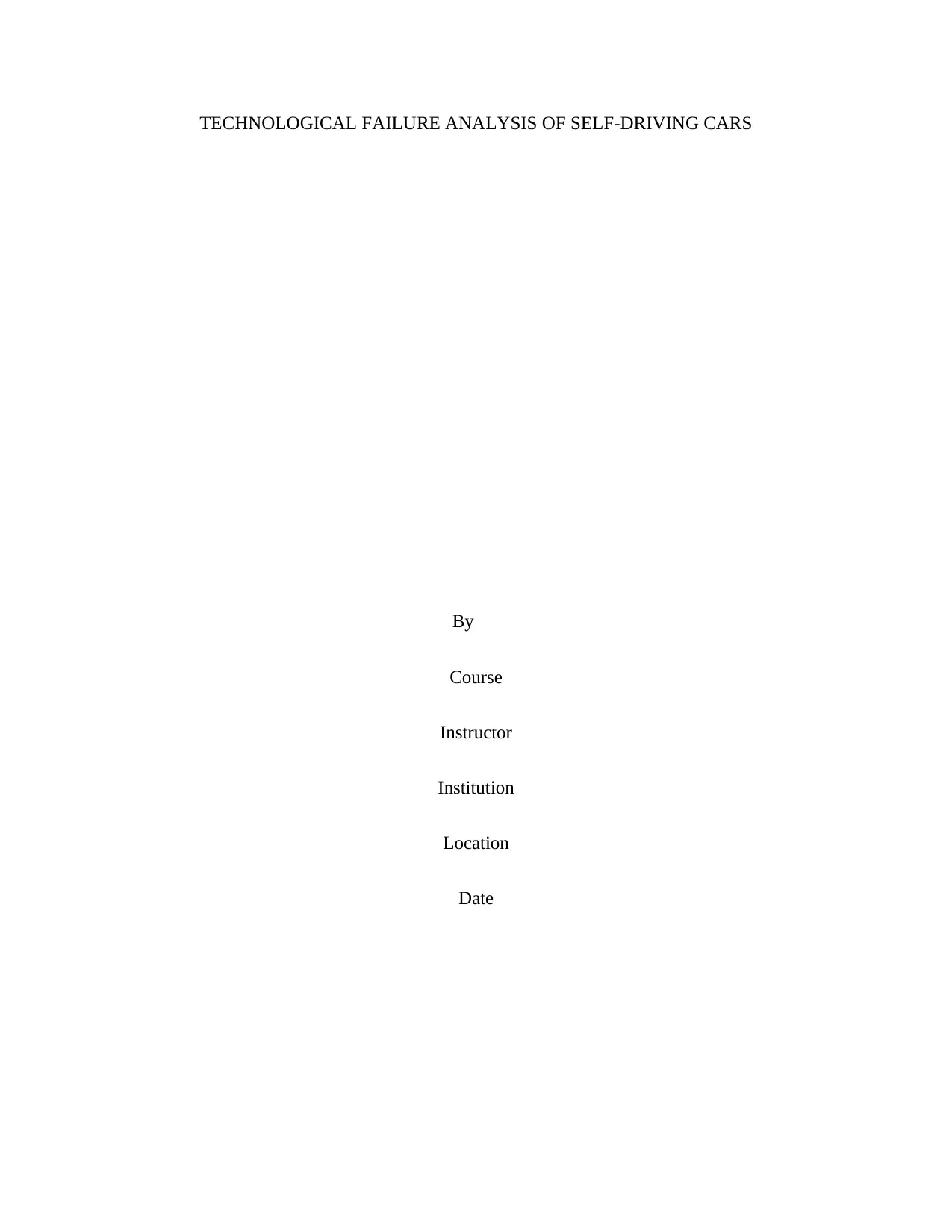
TECHNOLOGICAL FAILURE ANALYSIS OF SELF-DRIVING CARS
By
Course
Instructor
Institution
Location
Date
By
Course
Instructor
Institution
Location
Date
Paraphrase This Document
Need a fresh take? Get an instant paraphrase of this document with our AI Paraphraser
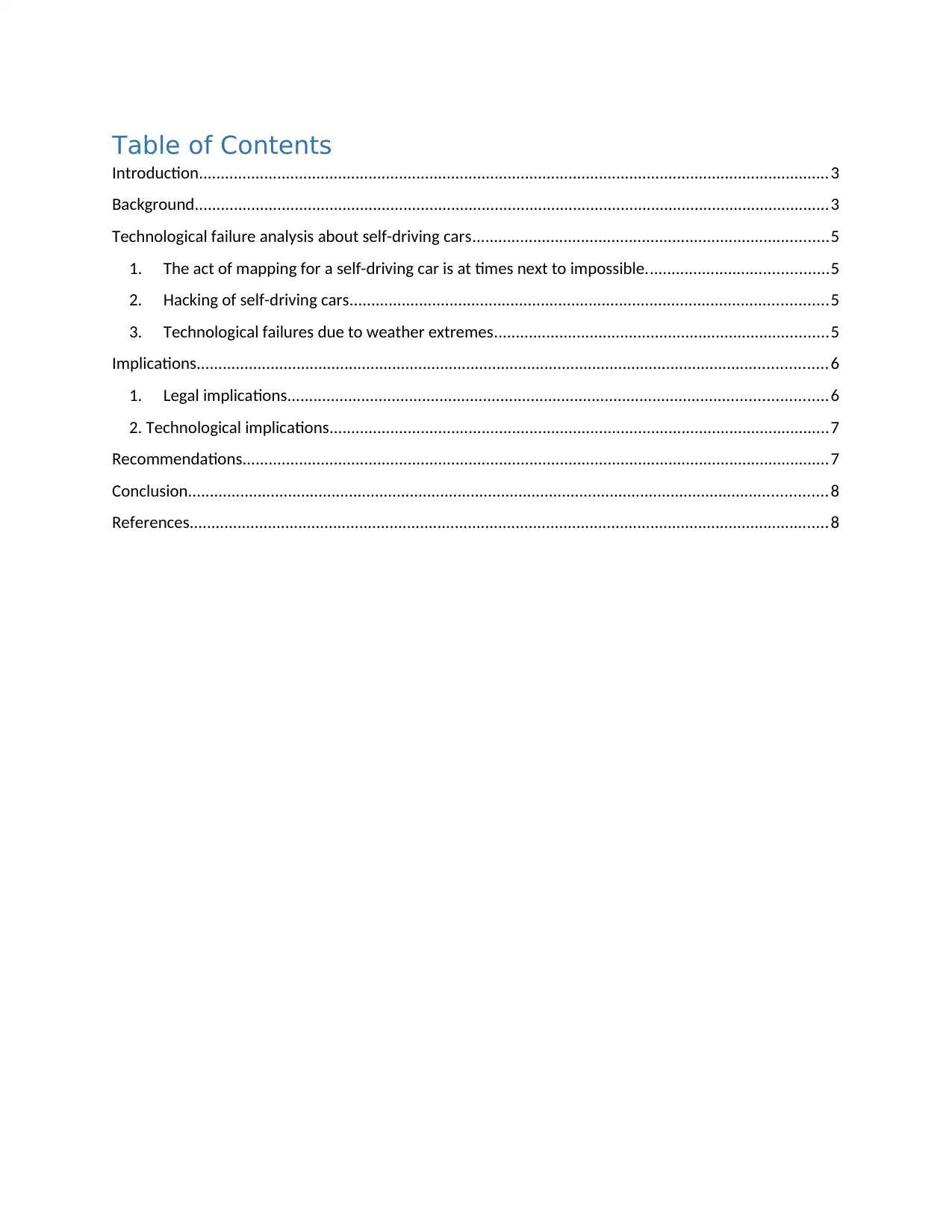
Table of Contents
Introduction.................................................................................................................................................3
Background..................................................................................................................................................3
Technological failure analysis about self-driving cars..................................................................................5
1. The act of mapping for a self-driving car is at times next to impossible..........................................5
2. Hacking of self-driving cars..............................................................................................................5
3. Technological failures due to weather extremes.............................................................................5
Implications.................................................................................................................................................6
1. Legal implications............................................................................................................................6
2. Technological implications...................................................................................................................7
Recommendations.......................................................................................................................................7
Conclusion...................................................................................................................................................8
References...................................................................................................................................................8
Introduction.................................................................................................................................................3
Background..................................................................................................................................................3
Technological failure analysis about self-driving cars..................................................................................5
1. The act of mapping for a self-driving car is at times next to impossible..........................................5
2. Hacking of self-driving cars..............................................................................................................5
3. Technological failures due to weather extremes.............................................................................5
Implications.................................................................................................................................................6
1. Legal implications............................................................................................................................6
2. Technological implications...................................................................................................................7
Recommendations.......................................................................................................................................7
Conclusion...................................................................................................................................................8
References...................................................................................................................................................8
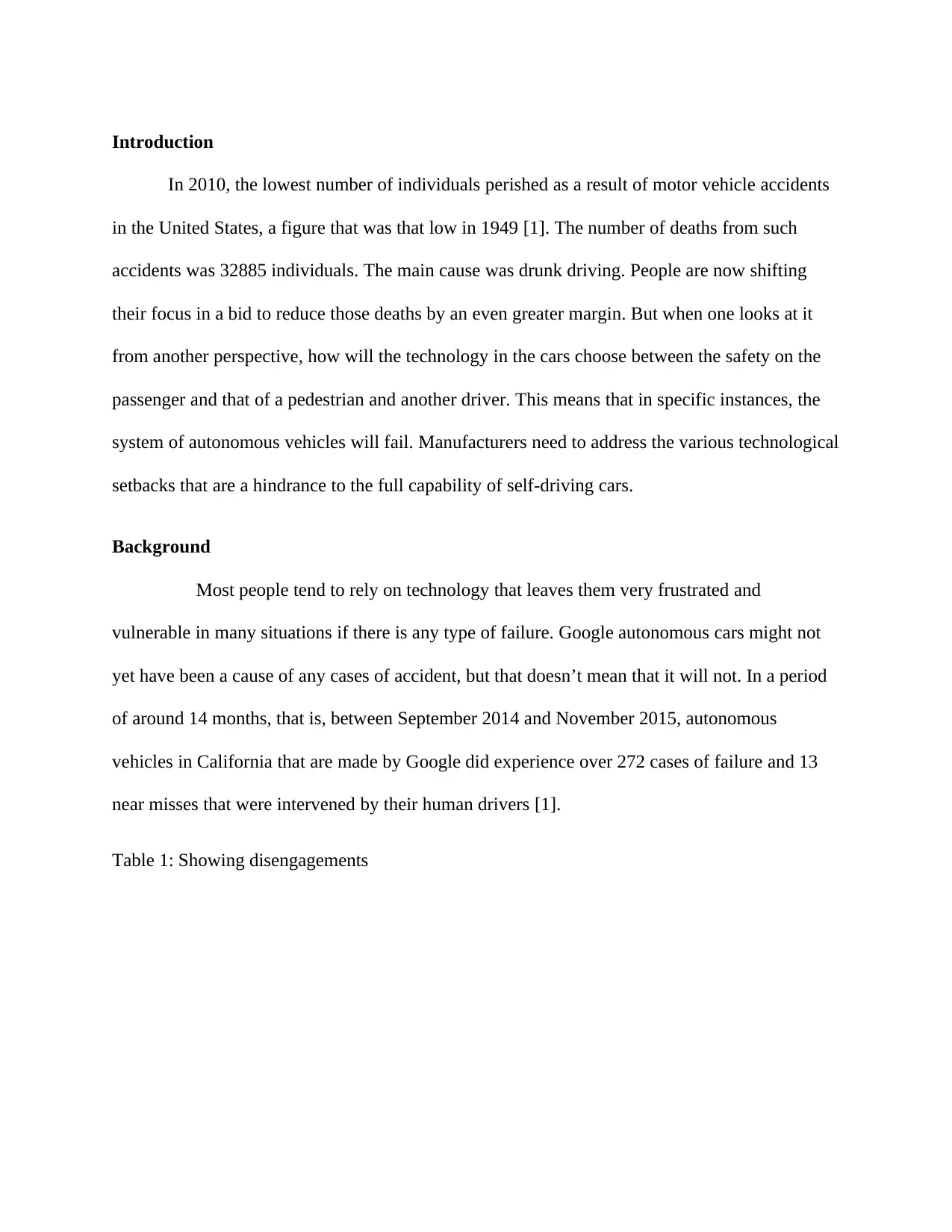
Introduction
In 2010, the lowest number of individuals perished as a result of motor vehicle accidents
in the United States, a figure that was that low in 1949 [1]. The number of deaths from such
accidents was 32885 individuals. The main cause was drunk driving. People are now shifting
their focus in a bid to reduce those deaths by an even greater margin. But when one looks at it
from another perspective, how will the technology in the cars choose between the safety on the
passenger and that of a pedestrian and another driver. This means that in specific instances, the
system of autonomous vehicles will fail. Manufacturers need to address the various technological
setbacks that are a hindrance to the full capability of self-driving cars.
Background
Most people tend to rely on technology that leaves them very frustrated and
vulnerable in many situations if there is any type of failure. Google autonomous cars might not
yet have been a cause of any cases of accident, but that doesn’t mean that it will not. In a period
of around 14 months, that is, between September 2014 and November 2015, autonomous
vehicles in California that are made by Google did experience over 272 cases of failure and 13
near misses that were intervened by their human drivers [1].
Table 1: Showing disengagements
In 2010, the lowest number of individuals perished as a result of motor vehicle accidents
in the United States, a figure that was that low in 1949 [1]. The number of deaths from such
accidents was 32885 individuals. The main cause was drunk driving. People are now shifting
their focus in a bid to reduce those deaths by an even greater margin. But when one looks at it
from another perspective, how will the technology in the cars choose between the safety on the
passenger and that of a pedestrian and another driver. This means that in specific instances, the
system of autonomous vehicles will fail. Manufacturers need to address the various technological
setbacks that are a hindrance to the full capability of self-driving cars.
Background
Most people tend to rely on technology that leaves them very frustrated and
vulnerable in many situations if there is any type of failure. Google autonomous cars might not
yet have been a cause of any cases of accident, but that doesn’t mean that it will not. In a period
of around 14 months, that is, between September 2014 and November 2015, autonomous
vehicles in California that are made by Google did experience over 272 cases of failure and 13
near misses that were intervened by their human drivers [1].
Table 1: Showing disengagements
⊘ This is a preview!⊘
Do you want full access?
Subscribe today to unlock all pages.

Trusted by 1+ million students worldwide
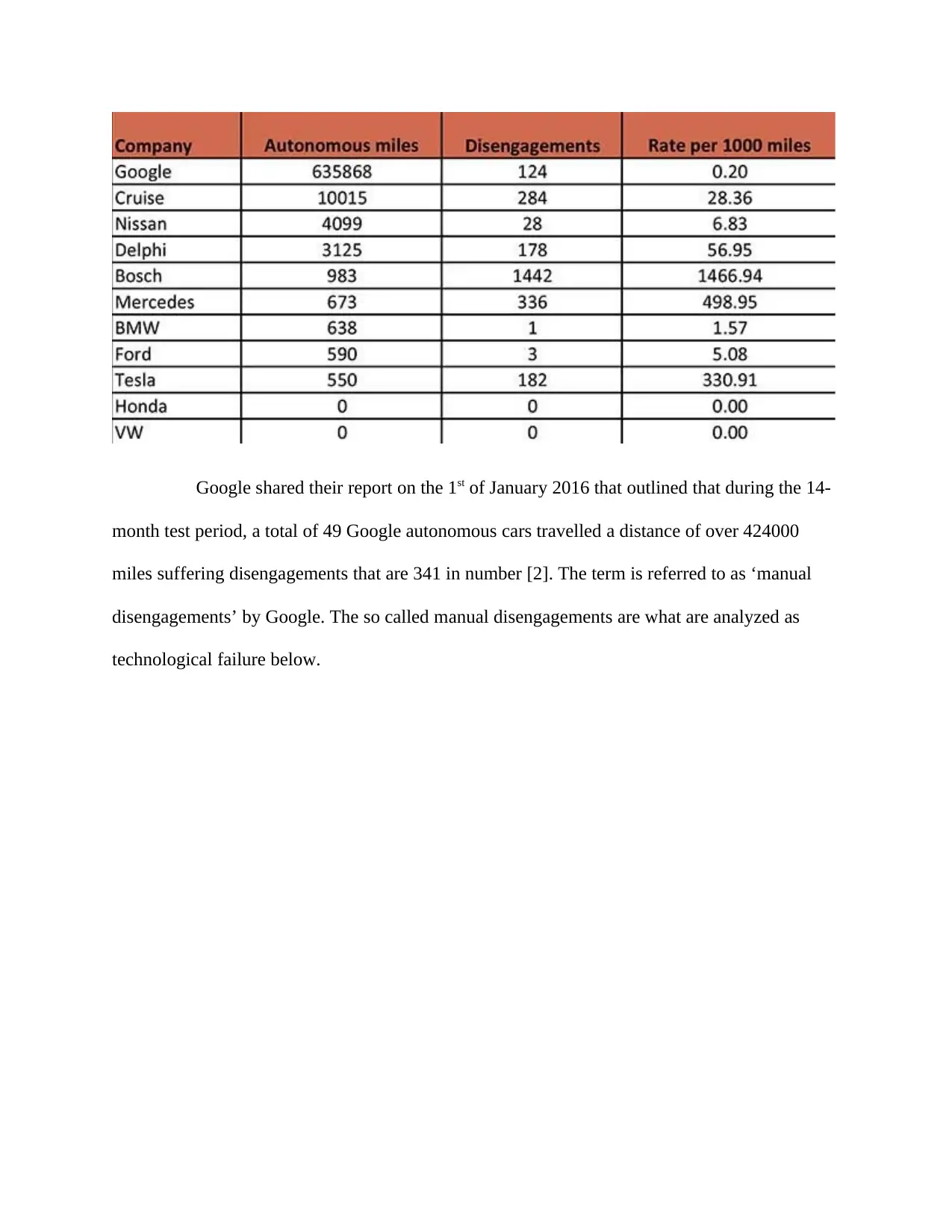
Google shared their report on the 1st of January 2016 that outlined that during the 14-
month test period, a total of 49 Google autonomous cars travelled a distance of over 424000
miles suffering disengagements that are 341 in number [2]. The term is referred to as ‘manual
disengagements’ by Google. The so called manual disengagements are what are analyzed as
technological failure below.
month test period, a total of 49 Google autonomous cars travelled a distance of over 424000
miles suffering disengagements that are 341 in number [2]. The term is referred to as ‘manual
disengagements’ by Google. The so called manual disengagements are what are analyzed as
technological failure below.
Paraphrase This Document
Need a fresh take? Get an instant paraphrase of this document with our AI Paraphraser
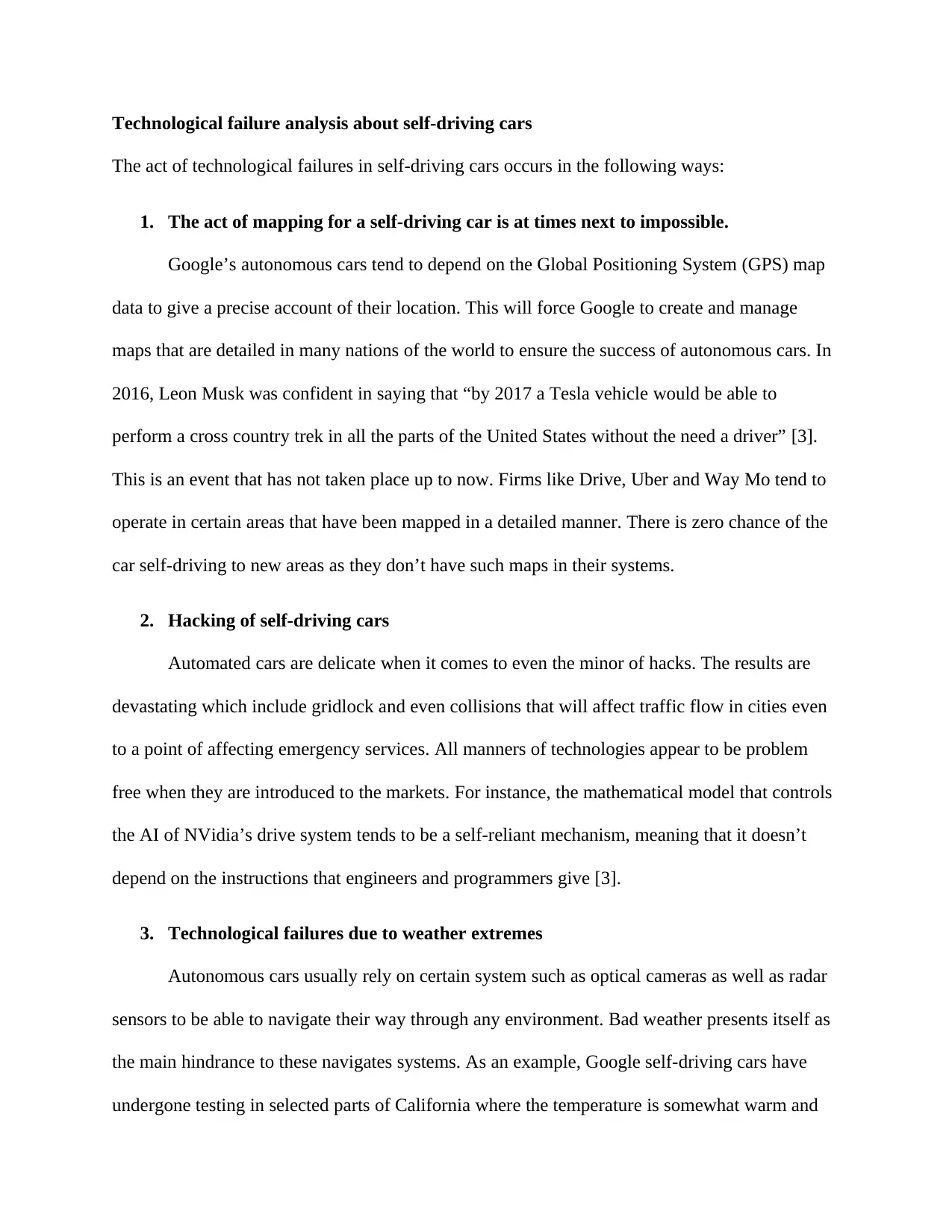
Technological failure analysis about self-driving cars
The act of technological failures in self-driving cars occurs in the following ways:
1. The act of mapping for a self-driving car is at times next to impossible.
Google’s autonomous cars tend to depend on the Global Positioning System (GPS) map
data to give a precise account of their location. This will force Google to create and manage
maps that are detailed in many nations of the world to ensure the success of autonomous cars. In
2016, Leon Musk was confident in saying that “by 2017 a Tesla vehicle would be able to
perform a cross country trek in all the parts of the United States without the need a driver” [3].
This is an event that has not taken place up to now. Firms like Drive, Uber and Way Mo tend to
operate in certain areas that have been mapped in a detailed manner. There is zero chance of the
car self-driving to new areas as they don’t have such maps in their systems.
2. Hacking of self-driving cars
Automated cars are delicate when it comes to even the minor of hacks. The results are
devastating which include gridlock and even collisions that will affect traffic flow in cities even
to a point of affecting emergency services. All manners of technologies appear to be problem
free when they are introduced to the markets. For instance, the mathematical model that controls
the AI of NVidia’s drive system tends to be a self-reliant mechanism, meaning that it doesn’t
depend on the instructions that engineers and programmers give [3].
3. Technological failures due to weather extremes
Autonomous cars usually rely on certain system such as optical cameras as well as radar
sensors to be able to navigate their way through any environment. Bad weather presents itself as
the main hindrance to these navigates systems. As an example, Google self-driving cars have
undergone testing in selected parts of California where the temperature is somewhat warm and
The act of technological failures in self-driving cars occurs in the following ways:
1. The act of mapping for a self-driving car is at times next to impossible.
Google’s autonomous cars tend to depend on the Global Positioning System (GPS) map
data to give a precise account of their location. This will force Google to create and manage
maps that are detailed in many nations of the world to ensure the success of autonomous cars. In
2016, Leon Musk was confident in saying that “by 2017 a Tesla vehicle would be able to
perform a cross country trek in all the parts of the United States without the need a driver” [3].
This is an event that has not taken place up to now. Firms like Drive, Uber and Way Mo tend to
operate in certain areas that have been mapped in a detailed manner. There is zero chance of the
car self-driving to new areas as they don’t have such maps in their systems.
2. Hacking of self-driving cars
Automated cars are delicate when it comes to even the minor of hacks. The results are
devastating which include gridlock and even collisions that will affect traffic flow in cities even
to a point of affecting emergency services. All manners of technologies appear to be problem
free when they are introduced to the markets. For instance, the mathematical model that controls
the AI of NVidia’s drive system tends to be a self-reliant mechanism, meaning that it doesn’t
depend on the instructions that engineers and programmers give [3].
3. Technological failures due to weather extremes
Autonomous cars usually rely on certain system such as optical cameras as well as radar
sensors to be able to navigate their way through any environment. Bad weather presents itself as
the main hindrance to these navigates systems. As an example, Google self-driving cars have
undergone testing in selected parts of California where the temperature is somewhat warm and
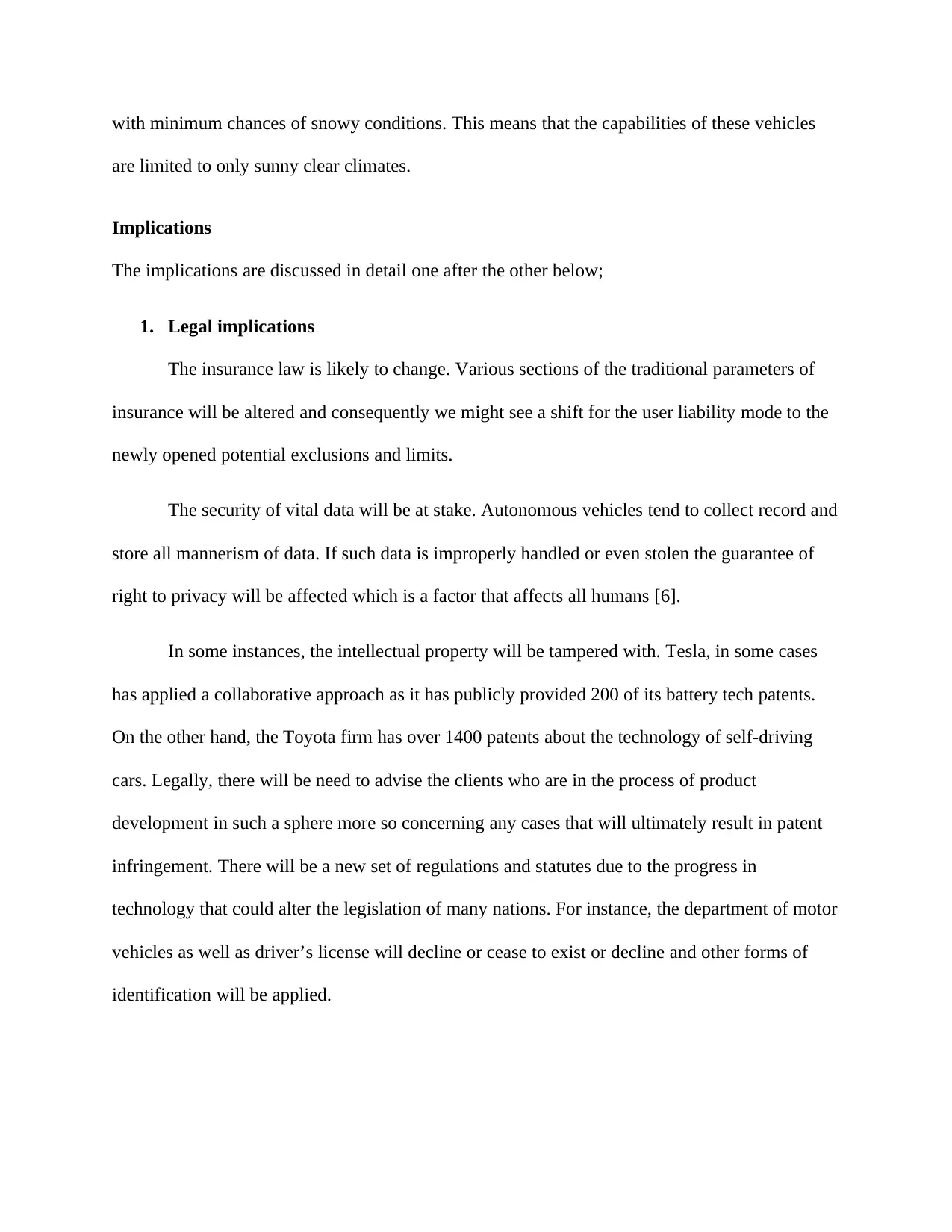
with minimum chances of snowy conditions. This means that the capabilities of these vehicles
are limited to only sunny clear climates.
Implications
The implications are discussed in detail one after the other below;
1. Legal implications
The insurance law is likely to change. Various sections of the traditional parameters of
insurance will be altered and consequently we might see a shift for the user liability mode to the
newly opened potential exclusions and limits.
The security of vital data will be at stake. Autonomous vehicles tend to collect record and
store all mannerism of data. If such data is improperly handled or even stolen the guarantee of
right to privacy will be affected which is a factor that affects all humans [6].
In some instances, the intellectual property will be tampered with. Tesla, in some cases
has applied a collaborative approach as it has publicly provided 200 of its battery tech patents.
On the other hand, the Toyota firm has over 1400 patents about the technology of self-driving
cars. Legally, there will be need to advise the clients who are in the process of product
development in such a sphere more so concerning any cases that will ultimately result in patent
infringement. There will be a new set of regulations and statutes due to the progress in
technology that could alter the legislation of many nations. For instance, the department of motor
vehicles as well as driver’s license will decline or cease to exist or decline and other forms of
identification will be applied.
are limited to only sunny clear climates.
Implications
The implications are discussed in detail one after the other below;
1. Legal implications
The insurance law is likely to change. Various sections of the traditional parameters of
insurance will be altered and consequently we might see a shift for the user liability mode to the
newly opened potential exclusions and limits.
The security of vital data will be at stake. Autonomous vehicles tend to collect record and
store all mannerism of data. If such data is improperly handled or even stolen the guarantee of
right to privacy will be affected which is a factor that affects all humans [6].
In some instances, the intellectual property will be tampered with. Tesla, in some cases
has applied a collaborative approach as it has publicly provided 200 of its battery tech patents.
On the other hand, the Toyota firm has over 1400 patents about the technology of self-driving
cars. Legally, there will be need to advise the clients who are in the process of product
development in such a sphere more so concerning any cases that will ultimately result in patent
infringement. There will be a new set of regulations and statutes due to the progress in
technology that could alter the legislation of many nations. For instance, the department of motor
vehicles as well as driver’s license will decline or cease to exist or decline and other forms of
identification will be applied.
⊘ This is a preview!⊘
Do you want full access?
Subscribe today to unlock all pages.

Trusted by 1+ million students worldwide
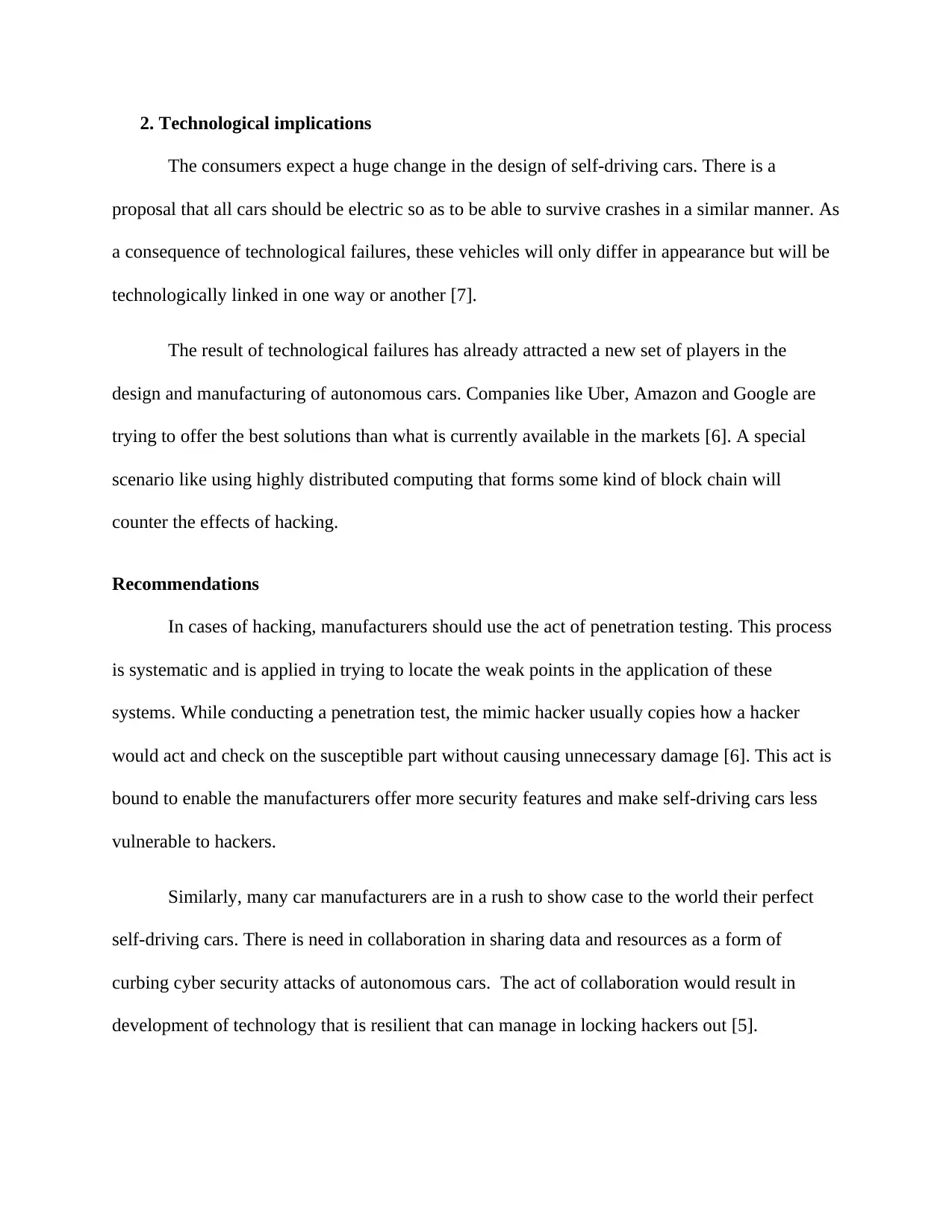
2. Technological implications
The consumers expect a huge change in the design of self-driving cars. There is a
proposal that all cars should be electric so as to be able to survive crashes in a similar manner. As
a consequence of technological failures, these vehicles will only differ in appearance but will be
technologically linked in one way or another [7].
The result of technological failures has already attracted a new set of players in the
design and manufacturing of autonomous cars. Companies like Uber, Amazon and Google are
trying to offer the best solutions than what is currently available in the markets [6]. A special
scenario like using highly distributed computing that forms some kind of block chain will
counter the effects of hacking.
Recommendations
In cases of hacking, manufacturers should use the act of penetration testing. This process
is systematic and is applied in trying to locate the weak points in the application of these
systems. While conducting a penetration test, the mimic hacker usually copies how a hacker
would act and check on the susceptible part without causing unnecessary damage [6]. This act is
bound to enable the manufacturers offer more security features and make self-driving cars less
vulnerable to hackers.
Similarly, many car manufacturers are in a rush to show case to the world their perfect
self-driving cars. There is need in collaboration in sharing data and resources as a form of
curbing cyber security attacks of autonomous cars. The act of collaboration would result in
development of technology that is resilient that can manage in locking hackers out [5].
The consumers expect a huge change in the design of self-driving cars. There is a
proposal that all cars should be electric so as to be able to survive crashes in a similar manner. As
a consequence of technological failures, these vehicles will only differ in appearance but will be
technologically linked in one way or another [7].
The result of technological failures has already attracted a new set of players in the
design and manufacturing of autonomous cars. Companies like Uber, Amazon and Google are
trying to offer the best solutions than what is currently available in the markets [6]. A special
scenario like using highly distributed computing that forms some kind of block chain will
counter the effects of hacking.
Recommendations
In cases of hacking, manufacturers should use the act of penetration testing. This process
is systematic and is applied in trying to locate the weak points in the application of these
systems. While conducting a penetration test, the mimic hacker usually copies how a hacker
would act and check on the susceptible part without causing unnecessary damage [6]. This act is
bound to enable the manufacturers offer more security features and make self-driving cars less
vulnerable to hackers.
Similarly, many car manufacturers are in a rush to show case to the world their perfect
self-driving cars. There is need in collaboration in sharing data and resources as a form of
curbing cyber security attacks of autonomous cars. The act of collaboration would result in
development of technology that is resilient that can manage in locking hackers out [5].
Paraphrase This Document
Need a fresh take? Get an instant paraphrase of this document with our AI Paraphraser
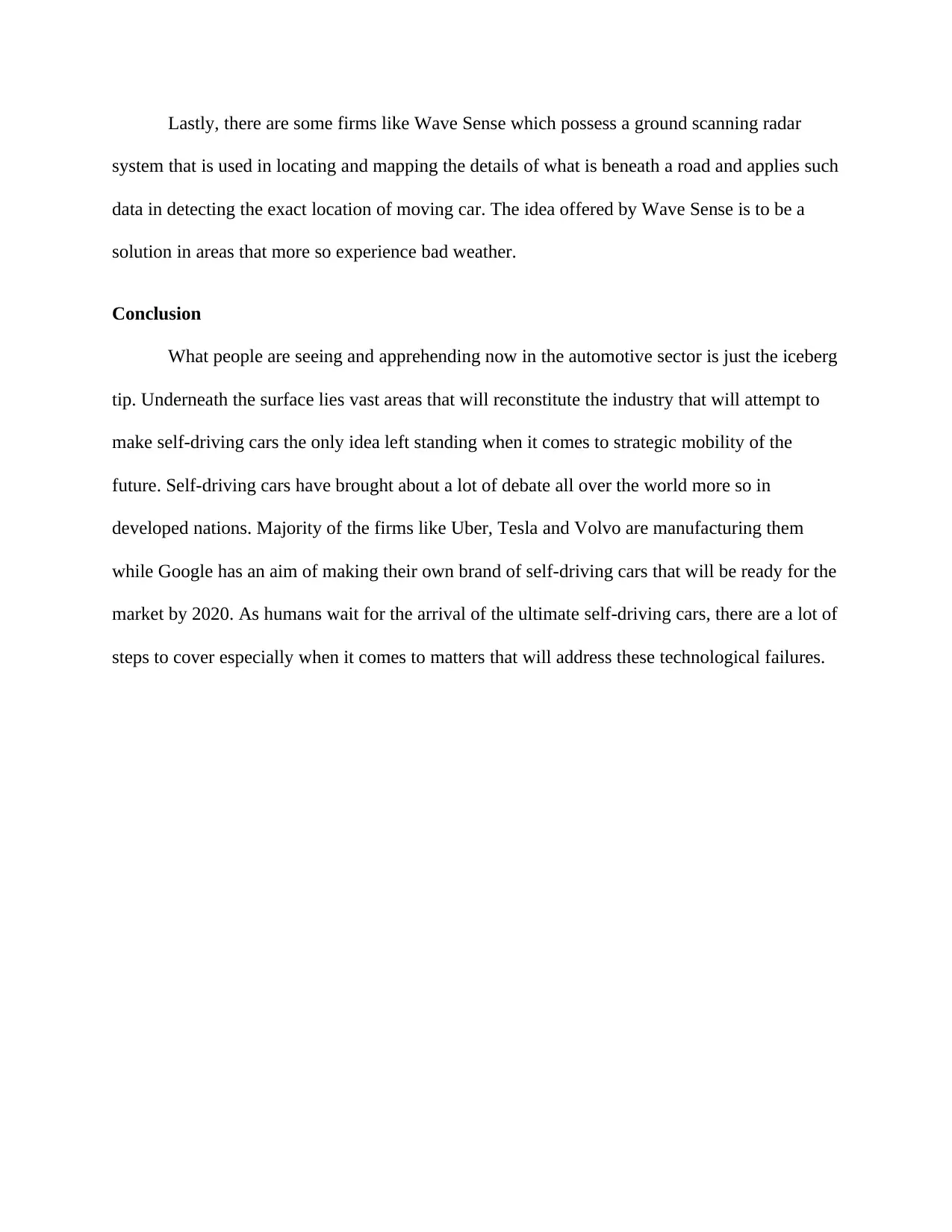
Lastly, there are some firms like Wave Sense which possess a ground scanning radar
system that is used in locating and mapping the details of what is beneath a road and applies such
data in detecting the exact location of moving car. The idea offered by Wave Sense is to be a
solution in areas that more so experience bad weather.
Conclusion
What people are seeing and apprehending now in the automotive sector is just the iceberg
tip. Underneath the surface lies vast areas that will reconstitute the industry that will attempt to
make self-driving cars the only idea left standing when it comes to strategic mobility of the
future. Self-driving cars have brought about a lot of debate all over the world more so in
developed nations. Majority of the firms like Uber, Tesla and Volvo are manufacturing them
while Google has an aim of making their own brand of self-driving cars that will be ready for the
market by 2020. As humans wait for the arrival of the ultimate self-driving cars, there are a lot of
steps to cover especially when it comes to matters that will address these technological failures.
system that is used in locating and mapping the details of what is beneath a road and applies such
data in detecting the exact location of moving car. The idea offered by Wave Sense is to be a
solution in areas that more so experience bad weather.
Conclusion
What people are seeing and apprehending now in the automotive sector is just the iceberg
tip. Underneath the surface lies vast areas that will reconstitute the industry that will attempt to
make self-driving cars the only idea left standing when it comes to strategic mobility of the
future. Self-driving cars have brought about a lot of debate all over the world more so in
developed nations. Majority of the firms like Uber, Tesla and Volvo are manufacturing them
while Google has an aim of making their own brand of self-driving cars that will be ready for the
market by 2020. As humans wait for the arrival of the ultimate self-driving cars, there are a lot of
steps to cover especially when it comes to matters that will address these technological failures.
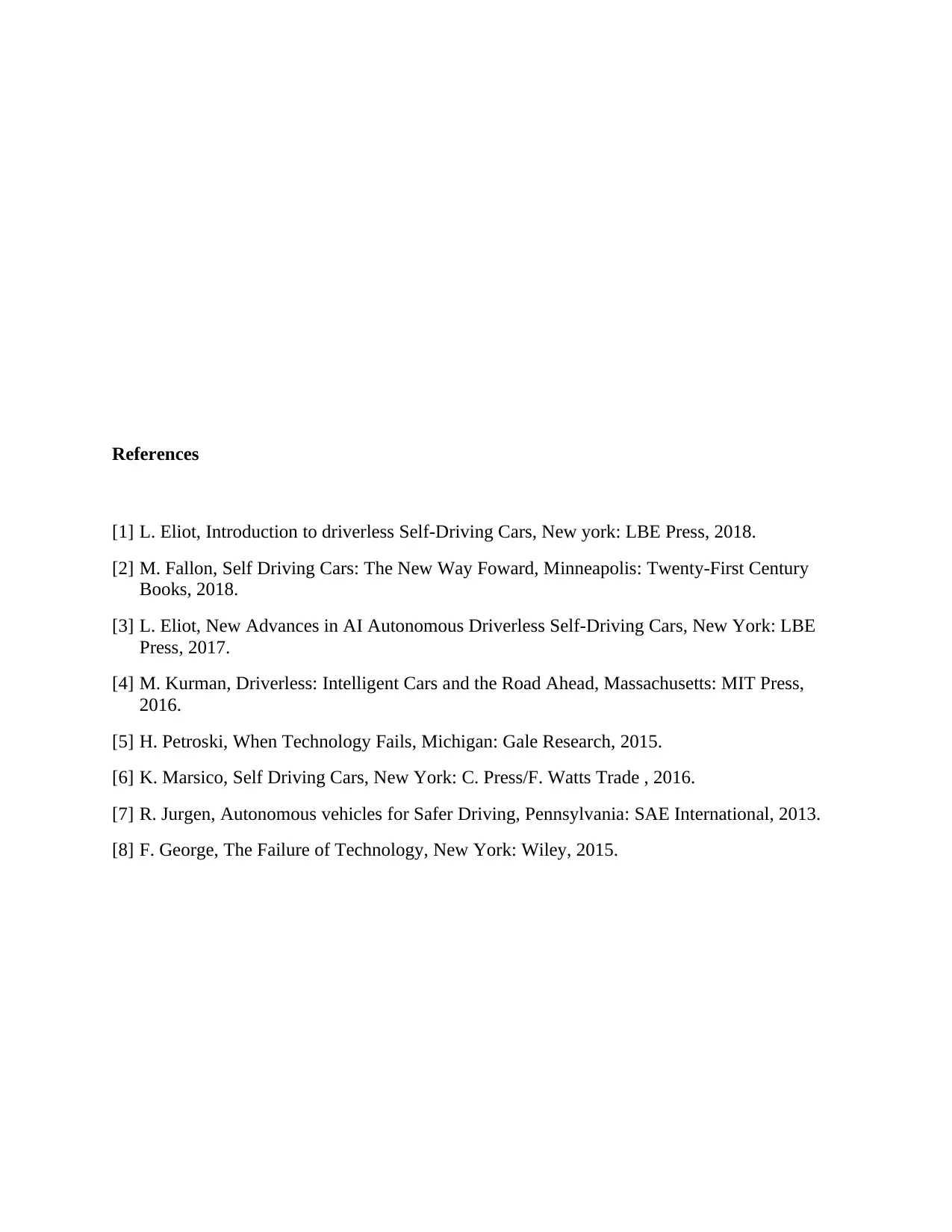
References
[1] L. Eliot, Introduction to driverless Self-Driving Cars, New york: LBE Press, 2018.
[2] M. Fallon, Self Driving Cars: The New Way Foward, Minneapolis: Twenty-First Century
Books, 2018.
[3] L. Eliot, New Advances in AI Autonomous Driverless Self-Driving Cars, New York: LBE
Press, 2017.
[4] M. Kurman, Driverless: Intelligent Cars and the Road Ahead, Massachusetts: MIT Press,
2016.
[5] H. Petroski, When Technology Fails, Michigan: Gale Research, 2015.
[6] K. Marsico, Self Driving Cars, New York: C. Press/F. Watts Trade , 2016.
[7] R. Jurgen, Autonomous vehicles for Safer Driving, Pennsylvania: SAE International, 2013.
[8] F. George, The Failure of Technology, New York: Wiley, 2015.
[1] L. Eliot, Introduction to driverless Self-Driving Cars, New york: LBE Press, 2018.
[2] M. Fallon, Self Driving Cars: The New Way Foward, Minneapolis: Twenty-First Century
Books, 2018.
[3] L. Eliot, New Advances in AI Autonomous Driverless Self-Driving Cars, New York: LBE
Press, 2017.
[4] M. Kurman, Driverless: Intelligent Cars and the Road Ahead, Massachusetts: MIT Press,
2016.
[5] H. Petroski, When Technology Fails, Michigan: Gale Research, 2015.
[6] K. Marsico, Self Driving Cars, New York: C. Press/F. Watts Trade , 2016.
[7] R. Jurgen, Autonomous vehicles for Safer Driving, Pennsylvania: SAE International, 2013.
[8] F. George, The Failure of Technology, New York: Wiley, 2015.
⊘ This is a preview!⊘
Do you want full access?
Subscribe today to unlock all pages.

Trusted by 1+ million students worldwide
1 out of 9
Related Documents
Your All-in-One AI-Powered Toolkit for Academic Success.
+13062052269
info@desklib.com
Available 24*7 on WhatsApp / Email
![[object Object]](/_next/static/media/star-bottom.7253800d.svg)
Unlock your academic potential
Copyright © 2020–2025 A2Z Services. All Rights Reserved. Developed and managed by ZUCOL.





